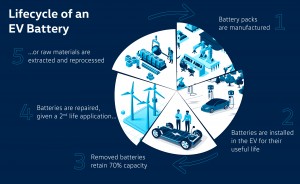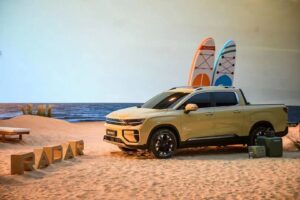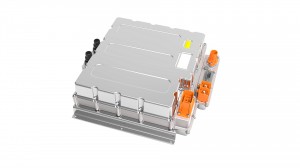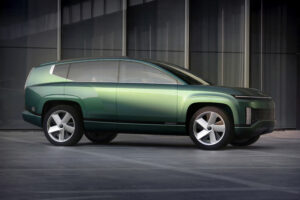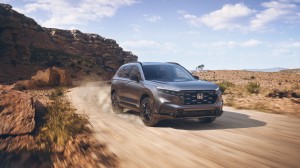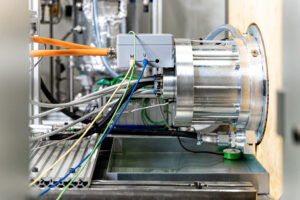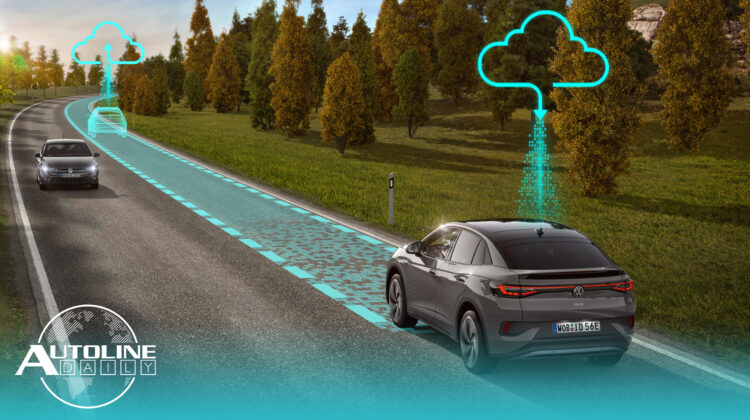
Listen to “AD #3361 – Panasonic Develops Better EV Battery; VW Faces Delays Due to Software; IONIQ 6 Reveals New Styling Strategy” on Spreaker.
Follow us on social media:
Runtime: 10:53
0:07 Panasonic Develops Better EV Battery
0:51 VW Faces Major Delays Due to Software
1:59 VW Joins Battery Recycler Redwood Materials
3:44 Geely Launches EV Pickup
4:37 Vitesco Lands Big Business with Renault
5:24 IONIQ 6 Reveals Hyundai’s EV Styling Strategy
7:42 Honda CR-V Gets Major Redo
8:43 ZF Gets a New CEO
9:23 Mahle Develops EV Motor to Run Indefinitely
Visit our sponsors to thank them for their support of Autoline Daily: Bridgestone, Intrepid Control Systems, MEDC and Schaeffler.
This is Autoline Daily, the show dedicated to enthusiasts of the global automotive industry.
PANASONIC DEVELOPS 20% BETTER EV BATTERY
Panasonic is developing a battery with more energy density that could add 100 kilometers to the range of a Tesla Model Y with the same size battery pack. Panasonic is using a new mix of additives to allow individual cells to run at a higher voltage without hurting the batteries’ performance. The new battery is 20% more energy dense which means the energy density is likely around 900 watt-hours per liter compared to 750 wh/l today. Panasonic didn’t say when it plans to introduce the new chemistry and it did not reveal if it will use it in 2170 or 4680 sized batteries.
VW CARIAD FACES MAJOR DELAYS
Uh-oh. If this next item is true, it could be a disaster for Volkswagen. A German newspaper reports that VW’s software unit, Cariad, is way behind on development of a new software system for its upcoming EVs, which will cause significant delays. CEO Herbert Diess has said this technology will determine how successful the company is in the future and help close the gap to Tesla. Audi’s new flagship, which was teased with the Landjet concept, may not launch until 2027, three year later than initially planned. And Bentley’s move to go all-electric by the end of the decade is also in doubt. Worse still, the intermediate version of its software system is also said to be behind schedule. That threatens the launch of the electric versions of the Porsche Macan and Audi Q6. Those models were supposed to come out next year. We just wonder what the heck went so wrong with the Cariad project that it’s already running three years late even though the program just got started.
REDWOOD ADDS ANOTHER OEM CUSTOMER
Speaking of VW, it’s join forces with battery recycler Redwood Materials, which was started by Tesla co-founder JB Straubel. VW joins Ford, Toyota and Volvo as partners of Redwood. Battery recycling is going to be key to automakers getting the materials they need to hit their future EV targets. By 2030, Volkswagen and its brands plan to introduce 25 BEVs to the American market. Redwood will rely on VW’s dealer network to provide it with end-of-life batteries, first from the Volkswagen and Audi brands. The packs will be shipped off to Redwood’s Nevada facility in the U.S. where it will extract raw materials, which can then be remanufactured into critical battery components before being sent back to local cell manufacturers.
GEELY LAUNCHES EV PICKUP
Did you know that pickup trucks are banned in most cities in China? Even so, Geely is launching a new electric pickup truck under a newly created brand, called Radar Auto. Called the RD6, it’s built on Geely’s Sustainable Experience Architecture, which will also be used by Volvo and Polestar. It was designed by Peter Horbury, a British designer, who also worked at Ford and Volvo. It has a very unique front end design, but to us the silhouette kind of looks like the Honda Ridgeline. There’s not a lot of info on the truck but it will have single and dual motor setups as well as a driving range of more than 600 kilometers or 370 miles. Radar doesn’t plan to sell just trucks. It will also make SUVs and ATVs.
VITESCO LANDS MAJOR BUSINESS WITH RENAULT
Vitesco is the name of the supplier company that was spun out of the giant supplier Continental. Everyone wondered how Vistesco would survive in the long run because its main business is with conventional ICE powertrains. But Vitesco just signed an agreement with Renault to develop power electronics for EVs and hybrids. They plan to combine the converter, onboard charger and inverter into a single housing or what they call “One Box.” Renault says the more compact unit will allow it to free up more space for passengers. It will be built in France by Renault and the automaker plans to start equipping vehicles with the One Box in 2026 and will eventually use it in all of its EVs.
HYUNDAI IONIQ 6 SHOWS NEW STYLING STRATEGY
Hyundai will officially unveil the Ioniq 6 EV to the public tonight, and it’s part of an impressive EV strategy that relies heavily on expressive design for three different EV models. The first one out, the Ioniq 5, is already one of the best selling EVs in the market. It features hard-edged styling lines and sharp angles as part of its form language. But the Ioniq 6 goes in exactly the opposite direction. It’s very rounded and flowing and has a sloping rear roofline reminiscent of the Mercedes CLS. Even though it’s designed to look like it’s a coupe and Hyundai calls it a sedan, it’s actually got the functionality of a crossover with a large trunk opening. All automakers are struggling to come out with crossovers that don’t look like crossovers, so Hyundai really nailed it.
The third EV model in the lineup is an SUV that has only appeared as a concept. It’s big, boxy and squared off. But here’s our Autoline Insight and the most important point about the styling of these EVs. They don’t bear any kind of family resemblance. None of them look like the other. And they don’t look like any other Hyundai. And that’s deliberate. Hyundai is designing each of these EVs to appeal to different psychographic profiles of customers. You’ve got the hard-edged Ioniq 5, the free flowing Ioniq 6 and the techy SUV concept. Hyundai’s competitors better be worried. Hyundai is already the best selling EV brand in the US market outside of Tesla, and new models like these are only going to give it more momentum.
HONDA CR-V GETS MAJOR REDO
Honda fully revealed the all-new CR-V. We’ve already shown you the exterior and interior, but there are a few things we’d like to highlight. It’s longer and wider than before and the A-pillar was pushed back nearly 5-inches, which is meant to help improve visibility. The interior was inspired by the new Civic and comes standard with a 7-inch display screen, but a 9-inch version is also available. Power comes from either a 1.5L turbocharged 4-cylinder that makes 190 horsepower or a hybrid unit that consists of a 2.0L 4-cylinder that’s mated to a pair of electric motors, which combine for just over 200 horsepower. This setup also allows for a 1,000 pound towing capacity, something the CR-V was not rated to do before. All models will come with some form of driver assistance system. The new CR-V launches this summer, followed by the hybrid later in the year.
ZF GETS A NEW CEO
Big executive change at ZF, which is the third largest automotive supplier in the world. It’s getting a new CEO and Chairman. Dr. Holger Klein, who’s 52 years old, will take the reins of the company at the end of this year. He had been overseeing ZF’s Asia-Pacific region, its Car Chassis Technology Division, and its Aftermarket and Production units. ZF is one of the most unique suppliers in the industry. It’s actually owned by the Zeppelin Foundation of the City of Friedrichshafen in Germany. The foundation was created by Ferdinand von Zeppelin, the guy who invented the zeppelin.
MAHLE DEVELOPS EV MOTOR TO RUN INDEFINITELY
Speaking of suppliers, Mahle developed an electric motor for EVs that it says can run indefinitely even at high load. That’s thanks to a new kind of cooling system. And it can be used in passenger cars, commercial vehicles, and even construction equipment. They call it the SCT E-motor, and it features integrated oil cooling, which makes it more robust. And Mahle says the waste heat can be used in the vehicle’s complete system, presumably to keep batteries warm in cold weather, or even to help heat the passenger cabin. Interestingly, Mahle designed the electric motor to use permanent neodymium magnets, or as an induction motor without magnets. Since neodymium magnets use rare earth minerals and China dominates that supply chain, customers can go with the induction motor if they’re worried about market prices for rare earths, or even if they’re worried about geopolitical sourcing issues.
But that wraps up today’s show. Thanks for tuning in.
Thanks to our partner for embedding Autoline Daily on its website: WardsAuto.com
Seamus and Sean McElroy cover the latest news in the automotive industry for Autoline Daily.






